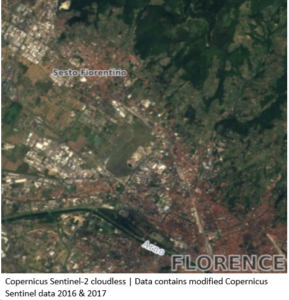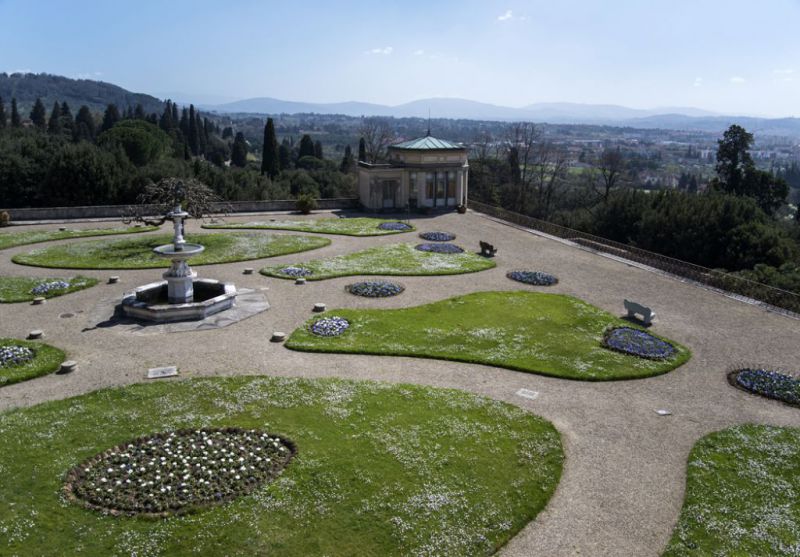SURPRISE takes off to Italy again this week, landing (virtually, of course!) in the Florence “Amerigo Vespucci” airport, just a few steps away from Sesto Fiorentino, home to the SURPRISE project coordinator IFAC-CNR.
So where are we exactly?
We are in Tuscany, less than 10 kilometres northwest of Florence. As you can see from the image captured by the Copernicus Sentinel-2 satellite, Sesto Fiorentino lies on a flat land area surrounded by Florence airport, the major industrial area of Osmannoro and Mount Morello, the main mountain of Florence area.
Sesto Fiorentino (Sesto, for locals) is part of Florence metropolitan area, with whom it has a special relation, as shown by its name: “sesto” is the short for the Latin expression “Sextus ab urbe lapis”, meaning that it is six miles away from Florence.

Why should I go to Sesto Fiorentino?
Sesto Fiorentino has Etruscan origins, as demonstrated by the Tomba della Montagnola and Tomba della Mula, two ancient Etruscan graves dating back to VII century.
The city started developing in the early Middle Ages, when some churches were built in the wide flat area, mainly inhabited by farmers and shepherds at the time. They include the Parish Church of St. Martin, which dates back to around 1000DC. It hosts paintings from the renowned artists Agnolo Gaddi and Jacopo Vignali and is still an active church, on one of the main squares of Sesto.
The renaissance was an extremely fruitful period for Sesto Fiorentino: as a part of the Florentine Republic, the area underwent major changes, the plain was dried and the local economy was boosted. Thanks to these improvements, to the vicinity to Florence and to its breath-taking hillside area, Sesto Fiorentino was the perfect retreat for Florentine nobles, who built their villas on Sesto’s hills. They are still there and open for sightseeing. Can’t wait to visit them in person? Then enjoy a virtual tour at Medici’s Villa della Petraia, at Villa Guicciardini Corsi Salviati or at Villa Gerini!
The city continued to grow over the centuries. In 1735 Marchese Carlo Ginori founded the Doccia Porcelain Manufactory (best known as Richard Ginori), the most important Italian porcelain factory ever since. Richard Ginori is renowned worldwide for their tableware and iconic pieces, especially for the Art Deco design characterising the Gio Ponti artistic direction in the 1920s. Want to know more about the three-century history of Richard Ginori? If it’s still early to visit their museum, you can have a look at this short video.
The industrial culture has remained a cornerstone for the city, which is now home to the largest industrial area of Florence (Osmannoro), housing a number of major Italian and international companies of various sectors. They include the fashion brand Salvatore Ferragamo and the pharma industry Ely Lilly, just to mention a couple.
So, we have ancient history, beautiful landscapes, artistic heritage and industry. Do you really need other reasons to visit Sesto Fiorentino? If you’re a book lover, here’s two that will have you plan your trip faster than light!
The book “The adventures of Pinocchio”, telling the story of the famous wooden puppet dreaming to become a real boy, takes place in Sesto Fiorentino. The author Carlo Collodi was the brother of Paolo, the director of Doccia Porcelain Manufactory for over 40 years, which brought him to Sesto Fiorentino very frequently. The garden of the above-mentioned Villa Gerini inspired Collodi for the “Field of Miracles”, where the Fox and the Cat try to convince Pinocchio that coins can be grown into a money tree.
Moreover, Sherlock Holmes scholars determined that Holmes reached Sesto Fiorentino shortly after 4th May 1891, when he pretended to die falling from a waterfall while fighting his deadly enemy Moriarty…as a matter of fact, a bust of Sherlock Holmes stands in the town!
So what about science and technology?
Sesto Fiorentino hosts the science pole and the OpenLab of Florence University. The research area alone covers an area of around 23.000 sqm, with over 600 people including employees, researchers and other staff. The pole, which was built starting from the late 1990s, is home to University departments of Physics, Experimental Physics, Chemistry and Pharmaceutical Sciences. It hosts a large scientific library, various interdepartmental laboratories (such as the crystallography structure lab) and two EU research centres: the European Magnetic Resonance Centre (CERM) and the European Laboratory for Non-Linear Spectroscopy (LENS).
The headquarters of the National Research Council (CNR) are also in the area of the scientific pole. Several institutes are here, including the Meterological Centre LaMMA, the Centre for Electron Microscopies (CeME), the Geophysics Consortium CEIE and, last but not least, the Institute for Applied Physics “Nello Carrara” (IFAC), the SURPRISE project coordinator.
IFAC is the largest institute of the CNR research area located at the science pole. It carries out research activities, experimental development and technological transfer in many areas of Applied Physics and ICT, such as space, aerospace and earth observation; health, nanomedicine and safety; environment and food quality monitoring; cultural heritage. The research unit involved in the SURPRISE project is the METEORS – Methods and Techniques for active and passive Optical Remote Sensing – group. They have high-level expertise in the design and development of optical instruments and methods, with particular reference to environmental monitoring and Earth Observation applications.
SURPRISE couldn’t have any better placed coordinator, don’t you think?
And what about its residents? What do they say about Sesto?
The Sestesi (people from Sesto) love living here! You are 10 minutes far from Florence and close to the airport, yet you can enjoy a relaxing residential area, with green spaces and quiet hills.
Residents know each other well and you can see them talking and waving at each other when they meet at the weekly outdoor market on Saturday mornings…indeed a regular appointment for locals!
Shepherds still live in the area and it’s not unusual that you get to meet sheep and goats while taking a break outside the CNR premises.
Sesto combines the dynamism of an industrial and research area of a large city, with the benefits of life in a small village. This is definitely the place to be!
Cover picture: View from Villa della Petraia, Photo by Polo Museale della Toscana

